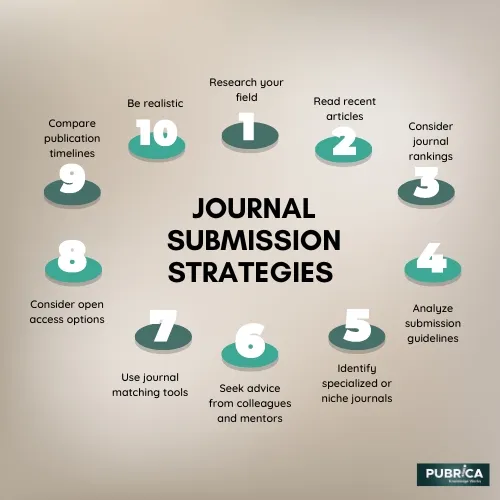
How Do Physician Assistants Contribute To Primary Health Care Systems
June 8, 2023
How Can I Ensure My Manuscript Is Peer Review By Experts In My Field
June 29, 2023Where Should Manuscripts Be Submitted Review of Journal Submission Approaches
Where Should Our Manuscript Be Submitted? A Review of Journal Submission Approaches
Table of Content
In this blog, we analyze the problem faced by impatient researchers attempting to balance the considerations of journal quality; paper submission lags, and acceptance probabilities in choosing appropriate outlets for their work. In this study, we look at the scenario when the probabilities of submission outcomes are exogenous factors, and we show how writers may select the best submission path by using peer-reviewed journal scores based solely on the qualities of the journals and the author’s level of impatience.
Introduction
Choosing the right journal to submit your manuscript is crucial for increasing the chances of acceptance and reaching your target audience. Here is an analysis of journal submission strategies to help you determine where to submit your manuscript:
- Research your field: Familiarize yourself with the leading journals in your research field. Look for journals that regularly publish articles on topics similar to your manuscript. Consider each journal’s impact factor, reputation, scope, and target audience.
- Read recent articles: Read recent articles published in potential target journals. This will help you understand the type and quality of research they publish, their writing style, and the level of detail expected. It will also give you insights into whether your research fits the journal selection scope well.
- Consider journal rankings: Explore journal rankings and metrics such as impact factor, h-index, or SCImago Journal Rank. While these metrics shouldn’t be the sole criteria for choosing a qualitative research journal, they can provide a general idea of its influence and reach within the academic community.
- Analyze submission guidelines: Carefully journal review each journal’s submission guidelines under consideration. Look for specific formatting requirements, word limits, citation styles, and other instructions. Ensure that your manuscriptaligns with these guidelines to avoid immediate rejection.

- Identify specialized or niche journals: Depending on your research topic, specialized journals may focus on specific subfields or interdisciplinary areas. Consider whether your research aligns with these journals, as they may offer a better fit and a more targeted readership.
- Seek advice from colleagues and mentors: Consult with your colleagues, mentors, or supervisors who are familiar with your research area. They may provide valuable insights or recommendations based on their own experiences or knowledge of the field.
- Use journal matching tools: Several online tools and platforms are available that can assist in finding suitable journals for your manuscript. These tools often consider factors such as keywords, abstracts, and the content of your manuscript to suggest relevant journals. Examples include Journal Finder by Elsevier, EndNote Manuscript Matcher, and JANE (Journal/Author Name Estimator).
- Consider open-access options: Open-access journals make research freely available to readers, potentially increasing its visibility and impact. Evaluate whether open access is a priority for your research, and consider the associated costs, such as article processing charges (APCs), when selecting a journal.
- Compare publication timelines: Review the average publication timelines of the journals you are considering. Some journals may have longer systematic review processes or publication backlogs, which could affect your research’s dissemination timeline.
- Be realistic: While it’s important to aim high and target reputable journals, be realistic about the scope and impact of your research. If your findings are incremental or preliminary, targeting journals with a slightly lower impact factor but a greater chance of acceptance may be more appropriate.
Remember that the journal selection process is iterative and may involve multiple rounds of research paper submissions. If your manuscript is rejected, consider the reviewers’ feedback, make necessary revisions, and target a different journal accordingly.
Conclusion
It’s important to note that the strategies mentioned above are general guidelines. It’s always advisable to carefully evaluate each journal based on the specific details and requirements provided by the respective publications before making a final decision.
About Pubrica
Pubrica adheres to the highest standards and procedures of journal publishing ethics at all stages of service and process. Pubrica follows the International Council of Medical Journal Editors’ (ICJME) authorship rules, and the scope of services is constantly updated in accordance with the Committee of Publication Ethics (COPE) and International Society of Medical Publication Professionals (ISMPP) principles.
References
Heintzelman Martin & Nocetti Diego, 2009. “Where Should we Submit Our Manuscript? An Analysis of Journal Submission Strategies,” The B.E. Journal of Economic Analysis & Policy, De Gruyter, vol. 9(1), pages 1-28, September.

14 years of expertise in clinical research with a doctoral distinction in life science.


